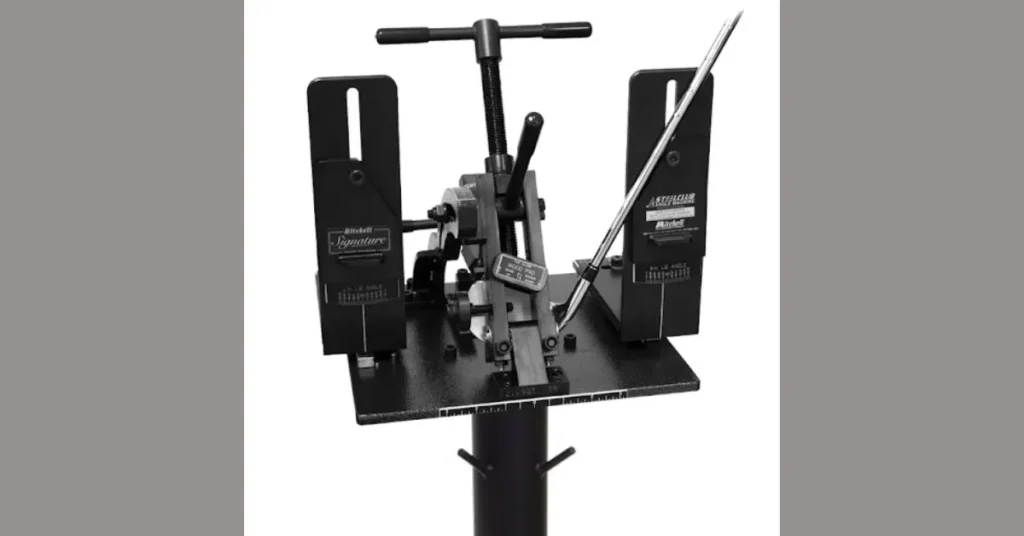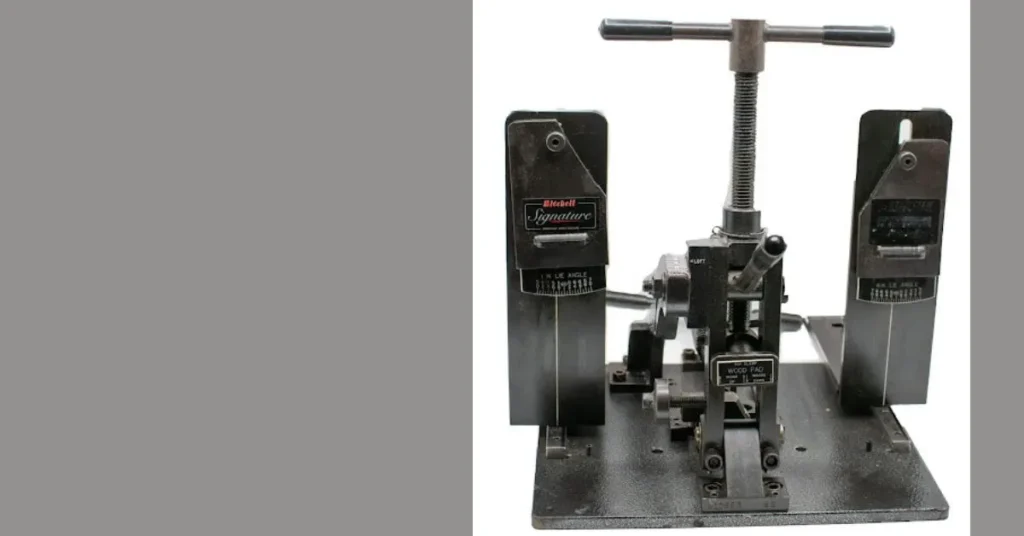In the intricate world of golf, the loft of a club emerges as a critical factor in shaping the game’s dynamics. For individual players and golf equipment companies, mastering the nuances of adjusting golf club loft is not just beneficial but essential. This capability, when bolstered by the presence of a reliable loft and lie adjustment machine in one’s facility, can significantly lead to marked improvements in accuracy and adaptability on the course.
What will you learn?
The forthcoming article delves into sophisticated techniques for bending golf clubs, offering insights catering to businesses and individual enthusiasts. We will explore the intricacies of loft and lie in golf clubs, revealing how strategic adjustments can unlock a higher level of play and provide a practical guide to refine this critical aspect of golf equipment.
Contents
Bending Golf Clubs: Understanding the Loft and Lie Angles
In golf, the loft and lie of a club are critical to its performance. The loft, the angle of the club face, dictates the trajectory and distance of the golf ball. A higher loft typically results in a higher, shorter shot, while a lower loft can achieve greater distance. The lie angle, the angle between the club’s shaft and ground, influences the shot’s accuracy.
Golfers must select the right combination of loft and lie for their playing style and the course conditions. This selection can profoundly impact the effectiveness of each swing.
Are you interested in learning more about bending golf clubs? Check out the related guide developed by a renowned golf equipment company.
Adjusting Golf Club Loft – Techniques and Methods
Adjusting loft in golf clubs is a precise process pivotal for optimal performance.
Golf Club Registration and Clamping:
- The first step involves club head registration and clamping, which is fundamental for accurate adjustments. This process begins with loosening the top clamp of the adjustment machine to prepare for the club head insertion.
- The club head is then carefully positioned against the machine’s face fixture, ensuring the sole rests securely on the sole clamps and the toe aligns with the toe stop.
- Once aligned, the club head is secured by tightening the top clamp. It’s crucial that the club face remains flush against the face fixture for consistency. This setup forms the base for any subsequent loft adjustments, whether increasing or decreasing the angle.
Proper registration and clamping are critical to fine-tuning the clubs. This method ensures that the adjustments made are precise, reflecting the nuanced needs of the golfer and the unique characteristics of each club.
- Metal Woods Adjustment Techniques:
Adjusting the loft and lie of metal woods is a delicate procedure, requiring precision and the right tools. Here’s a step-by-step guide developed by a golf equipment company for bending golf clubs using a loft and lie angle adjustment machine:
- Initial Setup: Begin by setting the face fixture of the machine at approximately 10 degrees in the Loft Gauge Swing Arm. This aligns with the metal wood’s loft for accurate measurement.
- Club Head Placement: Place the club head on the Wood Sole Fixture, ensuring the face is flush against the Face Fixture. The center of the club’s vertical face roll should contact the face fixture bars evenly.
- Aligning Club Head: Adjust the club head so its score lines are parallel to the leading edge of the Round Pivot Bracket. Slide the club head and Wood Sole Fixture together until the centering marks on the club face are aligned with the inside edge of the two vertical bars of the Face Fixture.
- Securing the Club: Tighten the Back Worm Screw until the Back Wood Clamp lightly holds the club head. Next, tighten the Top Worm Screw to secure the club with the Top Clamp Wood Pad. Ensure the club head remains centered and the score lines horizontal.
- Measuring and Adjusting: To measure the lie angle and face angle, slide the R.H. Lie/Face Angle Gauge Assembly forward and rotate it until the shaft is flush against the Vertical Plate. For lie angle adjustments, bend up for a more upright angle and down for a flatter angle. To adjust the face angle, bend up (back) to open the club face and down (forward) to close the club face.
Don’t Forget:
Remember, depending on the adjustment, the shaft should move in a plane parallel to the front or side of the machine. This method is critical for golf club repair shops that deliver precision-tuned clubs.
Hybrid Woods Adjustment Techniques:
Much like their metal wood counterparts, hybrid woods also demand precision and care when adjusting the golf club loft and lie angles. Here’s a detailed guide on how to use a golf club measuring machine for this purpose:
- Setting up the Machine: Initially, set the machine’s Loft Gauge Swing Arm to match the loft of the hybrid wood. Place the Hybrid Sole Fixture behind the Face Fixture, ensuring the Allen Bolt Heads fit into the slots on the plate of the Hybrid Sole Fixture.
- Club Head Positioning: Loosen the Worm Screws and position the club head on the Hybrid Sole Fixture. The club’s face should be flush against the Face Fixture. Ensure the center of the club’s vertical face roll contacts the face fixture bars evenly, with equal space exposed at the top and bottom.
- Aligning the Club Head: Adjust the club head so that the score lines are parallel to the Round Pivot Bracket’s leading edge. Slide the club head and the Hybrid Sole Fixture together until the centering marks on the club face are aligned with the inside edge of the Face Fixture’s two vertical bars.
- Securing the Club: Tighten the Back Worm Screw until the Back Wood Clamp lightly holds the club head. Follow this by tightening the Top Worm Screw to secure the club with the Top Clamp Wood Pad. Then alternate tightening both screws until the club is firmly clamped, ensuring the club head remains centered and the score lines horizontal.
- Measuring and Adjusting: To measure the lie and face angles, slide the R.H. Lie/Face Angle Gauge Assembly forward and rotate it until the shaft is flush against the Vertical Plate. For adjusting the lie angle, bend upwards for a more upright angle and downwards for a flatter angle. To adjust the face angle, bend upwards (back) to open the club face and downwards (forward) to close the club face.
This detailed method is integral for fine-tuning hybrid woods, blending control and power, and significantly impacting the player’s performance.
Metal vs. Hybrid Woods – What’s the Difference?
Adjusting the loft and lie in metal woods and hybrid woods, while similar in precision, differs in specific setup and clamping techniques. For metal woods, the machine’s Loft Gauge Swing Arm is set to match the club’s loft, and the club head is clamped without a toe stop. In contrast, hybrid woods require the Loft Gauge Swing Arm to be set according to the loft number on the hybrid, and they utilize a Hybrid Toe Stop for accurate clamping. These distinctions are critical for achieving precise adjustments, reflecting each club type’s unique design and playing characteristics.
Interested in learning more about bending golf clubs? Check out our related blog post.
Loft or Lie Angle – Which One to Adjust First?
Deciding whether to adjust the loft in golf clubs first or the lie angle often boils down to personal preference. Interestingly, with the right positioning of the bending bar, both adjustments can be made simultaneously.
However, precision is key in bending golf clubs. It’s common to alter the loft while adjusting the lie angle inadvertently. Therefore, starting with a clear reference point is essential. After each bend, it’s crucial to recheck and confirm that both loft and lie measurements align with your target specifications.
Signature Angle Machine:

The Signature Angle Machine is a robust tool for adjusting golf club loft and lie angles. Designed to handle irons, hybrids, and metal woods, this machine offers precision and ease of use, making it a top choice for a golf equipment company and individual players alike. Its features include adjustable bending bar positions, ensuring accurate adjustments for various club types. The machine’s durable construction and user-friendly design make it a reliable asset for bending golf clubs.
- Golf TourGauge Digital Putter Machine:
Separately, the TourGauge Digital Putter Machine specializes in putter adjustments. This machine brings digital precision to putter loft and lie adjustments, featuring an easy-to-read digital display for accurate measurements. Its versatility allows for adjustments on all putter styles, including those with extreme angles. This machine is a vital tool for ensuring putters are finely tuned to individual player specifications, enhancing performance on the green.
conclusion
In conclusion, adjusting golf club loft and bending golf clubs is a precise art. Their range of bending machines, renowned for their accuracy and durability, is a testament to this precision. They offer trusted tools on tours worldwide, from the versatile Signature Angle Machine to the digitally adept TourGauge Putter Machine.
For those seeking top-tier equipment for club adjustments, contact us and find the perfect one for your golfing needs.

